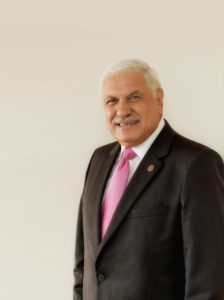Krakow
Poland
Mayor of Cuenca, Ecuador (July 2018)
Marcelo Cabrera

Civil Engineer with a Masters degree in Science from the University of London, a postgraduate degree in Groundwater Research from the Hebrew University of Jerusalem, Israel, and 20 years of experience as a politician. Since May 2014, he is Mayor of Cuenca for his second term. His first term as Mayor was from 2005 to 2009, when he was also President of the Andean Advisory Council of Municipal Authorities (CCAAM) and President of the Organization of World Heritage Cities (OWHC). He was Provincial Prefect of Azuay for two periods, from 1996 to 2000 and from 2000 to 2004. Previously, he was President of the Order of Civil Engineers of Azuay and Ecuador, Dean and Vice-Dean of the Faculty of engineering from the University of Cuenca and he was also a university professor. In the current period, as Mayor, he represents the city as a member of the Executive Bureau and World Council of the Global Network of United Cities and Local Governments (UCLG) and as President of the Andean Sub-Network of the Ibero-American Center for Strategic Urban Development (CIDEU). Under his current administration, the city of Cuenca hosted one of the pre-Habitat III thematic conferences. He is currently Vice-President of the Forum of Intermediate Cities of UCLG.
1. What has been the impact of the nomination of your city on the World Heritage List?
The inscription on the World Heritage List has allowed the city of Cuenca to be known internationally for its heritage value and for other features that make it an attractive tourist city, which is generating a change in the dynamics of the Historic Center. Over time, some uses that are aimed at providing services to tourists have increased, which requires us to think about the management and planning of the Historic Center. This is why we are working on implementing actions that guarantee a sustainable development for the Historic Center.
2. In your opinion, what is the vital role of a mayor when a city or a site in a city has been inscribed on UNESCO’s World Heritage List?
Establish public policies and take all necessary actions to safeguard cultural heritage. In addition, manage resources for plans, programs, and projects for the conservation of tangible and intangible heritage, with the aim of preserving the outstanding universal value of the declaration; and establish links with other cities on the UNESCO World Heritage List for sharing experiences in the management of the city.
3. Concretely, what have been your actions toward the protection and enhancement of your heritage?
The Municipal Autonomous Decentralised Government (GAD) of the Canton of Cuenca, through its Historic and Heritage Areas Department, responsible for developing and executing policies, plans and projects for the conservation of the historical and heritage areas of the Canton, realized several projects including the following:
- A Special Plan for the Historic Center of Cuenca, which includes heritage management and preservation policies and strategies.
- An evaluation plan for the urban and rural cultural heritage of the Canton of Cuenca, for updating the inventory and heritage conservation.
- The recovery of buildings with heritage value and property of GAD Cuenca, for different uses such as health, education, and culture.
- Coordination with other municipal agencies and citizen participation allow for the development of pilot projects, with the aim of improving the urban image of the Historic Center.
4. Do you hold special events to enhance your city’s heritage?
The Municipal GAD organizes several events that highlight the city’s heritage, including: Commemoration of the Declaration of Cuenca as a World Heritage Site, “National and International Meeting of Heritage Cities” as a space for discussion on the management and heritage planning, “Heritage Guardians” to teach and educate children about the importance of the city’s heritage, and the publication of books, by the Research Group of the Historic and Heritage Areas Department, on neighborhoods traditional buildings, recovered buildings and public spaces.
Within the institution, practical workshops on traditional construction techniques are also organized, craft fairs are planned on dates of foundation and independence, and there is collaboration for the planning of heritage celebrations in the public spaces of the city, especially for: Paseo del Niño, Corpus Christi and the Day of the Innocents.
5. In your opinion, what makes Cuenca such a special place?
Cuenca, a city that tells its story through architecture and urban development, with growth stages that are visible in building construction, materials and building systems.
Its topography allows us to appreciate the landscape from and to the city, surrounded by mountains. Streets, squares, and parks have become places to stay and meet locals and visitors. The Barranco, its four rivers, and the El Cajas National Park make Cuenca a unique city because of its relationship between the city and nature.
6. A recent study conducted by the University of Cuenca showed that there has been a 28.5 percent increase in tourist attendance in the city between 2016 and 2017. What are the impacts of tourism in your city?
The increase in tourism has enhanced the reputation of the city nationally and internationally through awards and recognitions, economic recovery, increased supply of gastronomic, hospital, cultural and mobility services. However, tourism demand has displaced traditional and residential uses of the Historic Center and increased the cost of land in areas of tourist interest, making them inaccessible to the local population.
News
Together towards the New Urban Project
Technical Assistance and Cooperation
Youth and citizens
Communication


